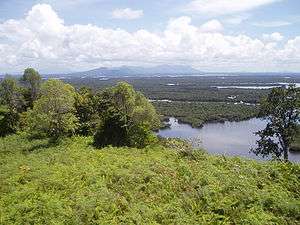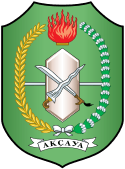West Kalimantan
| West Kalimantan Province Provinsi Kalimantan Barat | |||
|---|---|---|---|
| Province | |||
| Other transcription(s) | |||
| • Jawi | کاليمانتان بارت | ||
| • Chinese | 西加里曼丹 | ||
| |||
|
Nickname(s): Provinsi Seribu Sungai[1] Province of Thousand Rivers | |||
|
Motto: Akçaya (Sanskrit) (Immortal) | |||
 Location of Province of West Kalimantan in Indonesia | |||
| Coordinates: 0°0′N 110°30′E / 0.000°N 110.500°ECoordinates: 0°0′N 110°30′E / 0.000°N 110.500°E | |||
| Country |
| ||
| Capital |
| ||
| Government | |||
| • Governor | Cornelis (PDI-P & PD) | ||
| • Vice Governor | Christiandy Sanjaya | ||
| Area | |||
| • Total | 147,307 km2 (56,876 sq mi) | ||
| Area rank | 3rd | ||
| Population (2014)[2] | |||
| • Total | 4,546,439 | ||
| • Density | 31/km2 (80/sq mi) | ||
| Demographics | |||
| • Ethnic groups | Dayak (32.75%), Malay (29.75%), Chinese (29.21%), Javanese (5.25%), Bugis (0.3%) Others (9.85%)[3] | ||
| • Religion | Islam (51.22%), Roman Catholicism (23.94%), Protestantism (12.38%), Buddhism (12.21%), Confucianism (1.68%), Hinduism (0.06%) | ||
| • Languages | Indonesian (official), Malay (Pontianak Malay, Sambas Malay), Dayak (Iban, Kendayan, Jangkang, Bukar Sadong etc.), Chinese (Hakka, Teochew) | ||
| Time zone | WIB (UTC+7) | ||
| Vehicle registration | KB | ||
| HDI |
| ||
| HDI rank | 28th(2014) | ||
| Website | www.kalbarprov.go.id | ||
West Kalimantan (Indonesian: Kalimantan Barat, Chinese: 西加里曼丹; Teochew: Sai gia li màn dang) is a province of Indonesia. It is one of five Indonesian provinces in Kalimantan, the Indonesian part of the island of Borneo. Its capital city is Pontianak.
The province has an area of 147,307 km² with a recorded 2010 census population of 4,395,983 .[2] Ethnic groups include the Dayak, Malay, Chinese, Javanese, Bugis, and Madurese. The latest official estimate (as at January 2014) is 4,546,439.
The borders of West Kalimantan roughly trace the mountain ranges surrounding the watershed of the Kapuas River, which drains most of the province. The Province also bordered with Sarawak, Malaysia.
History
The history of West Kalimantan can be traced back to 17th century. Dayaks were the main inhabitants of the province before 17th century. The Malays migrated to West Kalimantan and established their own sultanates. The high Chinese population in this province was due to a republic founded by Chinese miners called Lanfang Republic (蘭芳共和國: Republik Lanfang) after they defeated the local Malay sultans. The government of Lanfang Republic was ended in West Kalimantan after the Dutch occupation in 1884.
West Kalimantan was under Japanese occupation from 1942 to 1945, when Indonesia declared its Independence. During the Japanese occupation, more than 21,000 people in Pontianak (including sultans, men, women and children) were kidnapped, tortured and massacred by Japanese troops during the Pontianak incidents. All the Malay Sultans on Kalimantan were executed and the Malay elite was devastated by the Japanese.
The massacre occurred from April 23, 1943 to June 28, 1944 and most of the victims were buried in several giant wells in Mandor (88 km from Pontianak). Allied forces occupying the area after the war found several thousand bones, and more than 60 years after the massacre, several secret graves of the victims were found in Mandor and the surrounding areas.
After the end of war, the Japanese officers in Pontianak were arrested by allied troops and brought in front of an international military tribune. During the trial, it was revealed that the plan to start the rebellion did not exist and instead was only an imaginary plan created by Japanese officers who wanted to get promoted.
A monument called Makam Juang Mandor was created to commemorate this tragic event.
| Historical population | ||
|---|---|---|
| Year | Pop. | ±% |
| 1971 | 2,019,936 | — |
| 1980 | 2,486,068 | +23.1% |
| 1990 | 3,229,153 | +29.9% |
| 1995 | 3,635,730 | +12.6% |
| 2000 | 4,034,178 | +11.0% |
| 2010 | 4,395,983 | +9.0% |
| Source: Badan Pusat Statistik 2010 | ||
West Kalimantan was the site of substantial fighting during the Indonesia-Malaysia confrontation under the Sukarno government in the mid-1960s. After Suharto deposed Sukarno in 1965, the confrontation was quickly resolved. Domestic conflict continued, however, for another ten years between the new military Suharto government and fighters organized during the confrontation and backed by the banned Indonesian Communist Party (PKI).(see Indonesian killings of 1965–66)
During the 1930s the Dutch colonial powers initiated a "transmigration plan" to move people from heavily populated islands such as Java, to the less populated islands of Irian Jaya and Kalimantan. In the 1960s the Indonesian government granted the Madurese rights to clear forests for palm oil cultivation. This conflicted with the local Dayak tribes' traditional way of life. The tensions between the two ethnic groups resulted in major eruptions of violence in 1996, the Sambas riots in 1999 and the Sampit conflict in 2001, resulting in thousands of deaths.[4][5][6]
Administrative divisions
West Kalimantan is subdivided into two cities (kota) and twelve regencies (kabupaten). About 29 percent of the province's population lives in the Pontianak area. The capitals and populations of the regencies and cities are:
| # | Name | Capital | Area in km2 | Population 2000 Census | Population 2010 Census[2] | Population 2014 estimate |
|---|---|---|---|---|---|---|
| 1 | Pontianak City | Pontianak | 107.80 | 472,220 | 554,764 | 573,751 |
| 2 | Singkawang City | Singkawang | 504.00 | (included) | 186,462 | 192,844 |
| 4 | Bengkayang Regency | Bengkayang | 5,075.48 | 333,089 | 215,277 | 222,645 |
| 10 | Kapuas Hulu Regency | Putussibau | 29,842.00 | 182,589 | 222,160 | 229,764 |
| 12 | Ketapang Regency | Ketapang | 31,240.74 | 426,285 | 427,460 | 442,090 |
| 13 | Kubu Raya Regency | Sungai Raya | 6,958.22 | (included) | 500,970 | 518,116 |
| 6 | Landak Regency | Ngabang | 8,915.10 | 282,026 | 329,649 | 340,931 |
| 11 | Melawi Regency | Nanga Pinoh | 10,640.80 | (included) | 178,645 | 184,759 |
| 14 | North Kayong Regency (Kayong Utara) | Sukadana | 4,568.26 | (included) | 95,594 | 98,866 |
| 5 | Pontianak Regency | Mempawah | 2,797.88 | 631,546 | 234,021 | 242,031 |
| 3 | Sambas Regency | Sambas | 6,716.52 | 454,126 | 496,120 | 513,100 |
| 7 | Sanggau Regency | Sanggau | 12,857.80 | 508,320 | 408,468 | 422,448 |
| 8 | Sekadau Regency | Sekadau | 5,444.20 | (included) | 181,634 | 187,851 |
| 9 | Sintang Regency | Sintang | 21,638.20 | 460,594 | 364,759 | 377,243 |
| # | Totals | Pontianak | 147,307.00 | 4,016,353 | 4,395,983 | 4,546,439 |
Notes:
- the use of "included" signifies that the regency was formed after 2000, and its population in 2000 has been included with that of the older regency from which it was taken. In 2003 Sekadau Regency was cut out of Sanggau Regency and Melawi Regency was cut out of Sintang Regency. In 2007 North Kayong Regency was cut out of Ketapang Regency, while Kuba Raya Regency was cut out of Pontianak Regency.
- above excludes a Special Enclave (Daerah Kantong), with 5,469 population in 2010.
Proposed new province of Kapuas Raya
On 25 October 2013, the Indonesian House of Representatives (DPR) began reviewing draft laws on the establishment of 57 prospective regencies and 8 new provinces; one of the proposed provinces is Kapuas Raya in West Kalimantan. If the bill is approved, this will make Kapuas Raya the fourth largest province in Indonesia after Papua, East Kalimantan and Central Kalimantan, as the total area of Kapuas Raya, encompassing five regencies, will measure 80,432 square km, or 54.79 percent of the current size of West Kalimantan. Ever since 2005, the five regencies in the eastern part of West Kalimantan (Sanggau, Sekadau, Sintang, Melawi and Kapuas Hulu) have floated a concept to establish Kapuas Raya due to the distance issues from the respective regencies to the province capital Pontianak. The distance between the farthest regency of Kapuas Hulu and Pontianak is 661 km, followed by Melawi (439 km), Sintang (395 km), Sekadau (315 km) and Sanggau (267 km).[7]
Ecology

There are three National Parks in the province: Danau Sentarum, Gunung Palung and Betung Kerihun. Currently, illegal logging for trees such as dipterocarp and plantations of palm oil and pulpwood threaten many rare species in the province due to the effects of habitat destruction.[8] Peat bog fires and droughts or flooding during ENSO episodes also threaten the area and are worsened by ongoing deforestation.
Dr. Hotlin Ompusunggu has received the 2011 Whitley Award for her conservation work in West Kalimantan. She has been fighting against illegal logging by trade off with low-cost quality dental and medical treatment to 60,000 villagers on condition they involve in reforestation and conservation work.[9]
Notes
- ↑ Pemerintah Provinsi Kalimantan Barat
- 1 2 3 Central Bureau of Statistics: Census 2010, retrieved 17 January 2011 (Indonesian)
- ↑ Overcoming Violent Conflict: Volume 1, Peace and Development Analysis in West Kalimantan, Central Kalimantan and Madura. (PDF). Prevention and Recovery Unit – United Nations Development Programme, LabSosio and BAPPENAS. 2005. Retrieved 15 January 2010.
- ↑ Armed Conflicts Report. Indonesia - Kalimantan
- ↑ Dayak
- ↑ THE RELATIONSHIP BETWEEN DAYAK AND MADURA IN RETOK by Yohanes Supriyadi
- ↑ Jakarta Post, 14 November 2013
- ↑ McVeigh, Tracy (January 28, 2011). "Greed and demand doom rainforest". Retrieved 28 January 2011.
- ↑ http://www.thejakartapost.com/news/2011/05/13/ri-conservationist-receives-award-british-royalty.html
References
- J. Braithwaite, V. Braithwaite, M. Cookson & L. Dunn, Anomie and Violence: Non-truth and Reconciliation in Indonesian Peacebuilding (ANU E-Press: 2010)
- Davidson, Jamie S. and Douglas Kammen (2002). Indonesia's unknown war and the lineages of violence in West Kalimantan. Indonesia 73:53.
- Yuan, Bing Ling (1999). Chinese Democracies - A Study of the Kongsis of West Borneo (1776–1884).
External links
- (English) Go West Kalimantan http://www.goarchi.com/archo/provinces/w-kalim/w-kalimtour.html
- (English) Kalimantan as a Tourism Destination http://www.extremeborneo.com/Kalimantan_Destinations.html
- (English) Golddiggers, Farmers, and Traders in the "Chinese Districts" of West Kalimantan, Indonesia https://books.google.com/books?id=4WK2s2ogHEAC&pg=PA34&source=gbs_selected_pages&cad=3#v=onepage&q&f=false
Template:Indonesia

